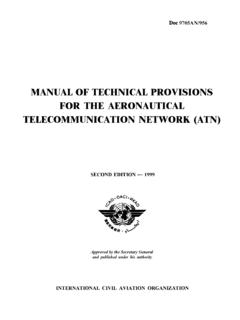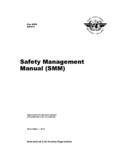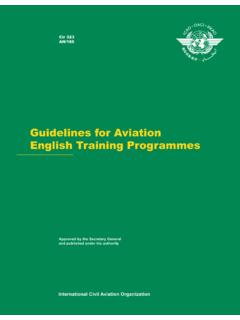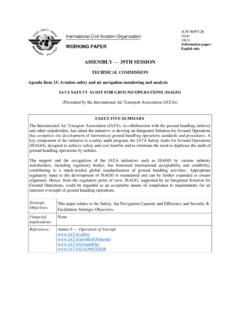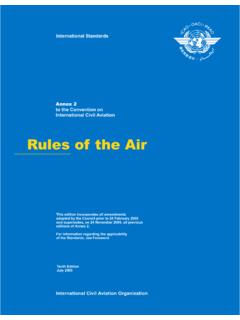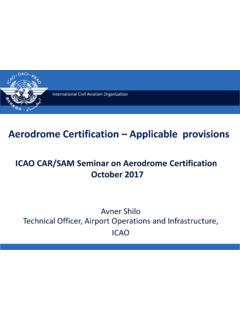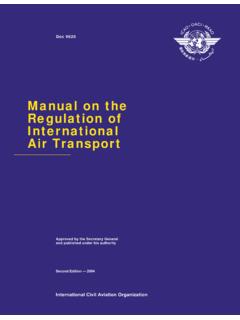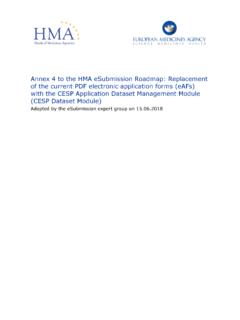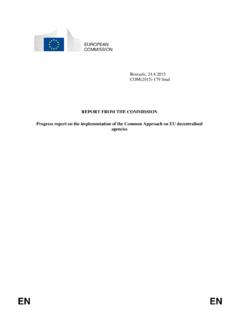Transcription of COMMON AERONAUTICAL VPN (CRV) IMPLEMENTATION …
1 INTERNATIONAL CIVIL AVIATION ORGANIZATION COMMON AERONAUTICAL VPN (CRV) IMPLEMENTATION PLAN Version 20 April 2018 COMMON AERONAUTICAL VPN (CRV) IMPLEMENTATION PLAN Page 2 of 69 Table of Contents ABBREVIATIONS .. 4 INTRODUCTION .. 6 Purpose .. 6 Overview of the CRV .. 6 IMPLEMENTATION OVERVIEW AND PROCESSES .. 7 General Description of IMPLEMENTATION .. 7 IMPLEMENTATION Schedule/ roadmap .. 7 Work Processes .. 7 roadmap for CRV .. 8 Application Transition Schemes .. 8 AMHS .. 8 AFTN .. 8 9 Voice .. 9 Technical Specifications of CRV (for applications reference) .. 9 Service Level Agreement & Quality of Service .. 10 IP Addressing .. 10 Interface .. 10 Routing 11 Packet Loss Rate .. 11 For VoIP Transport (ED-137) .. 11 Standards used .. 11 Use Cases.
2 11 IMPLEMENTATION SUPPORT .. 13 Introduction .. 13 IMPLEMENTATION Team .. 15 CRV-OG .. 15 National CRV Points of Contact .. 15 Local CRV Points of Contact .. 28 CRV Contractor .. 43 BASIC SITE IMPLEMENTATION REQUIREMENTS .. 44 Site/ Facilities Requirements .. 44 CRV User Responsibility .. 44 Contractor Responsibility .. 44 Hardware and Software Requirements .. 46 General Topics .. 46 Hardware 47 Software Requirements .. 47 TESTING AND EVALUATION.. 47 CONTINGENCY PLAN/ BACK-OFF PLAN .. 49 Purpose .. 49 Harmonized Contingency 49 MIXED OPERATING ENVIRONMENT .. 49 Routing of AFTN/ AMHS messages to non-CRV States/ Administrations .. 49 COMMON AERONAUTICAL VPN (CRV) IMPLEMENTATION PLAN Page 3 of 69 Inter-Region COMMON network 49 Appendix A .. 50 Appendix B .. 55 Appendix C.
3 69 COMMON AERONAUTICAL VPN (CRV) IMPLEMENTATION PLAN Page 4 of 69 ABBREVIATIONS ABBREVIATION DESCRIPTION AFTN AERONAUTICAL Fixed Telecommunication Network AIDC ATS Inter-facility Data Exchange AMHS Air Traffic Service Message Handling System ANSP Air Navigation Service Provider APANPIRG Asia/Pacific Air Navigation Planning and IMPLEMENTATION Regional Group APAC Asia/Pacific ATC Air Traffic Control ATM Air Traffic Management ATN AERONAUTICAL Telecommunication Network ATS Air Traffic Services BBIS Backbone Boundary Intermediate System BIS Boundary Intermediate System CAA Civil Aviation Authority CAR Caribbean Region CBA Cost Benefit Analysis CNS Communications, Navigation and Surveillance ConOps Concept of Operations CRV COMMON AERONAUTICAL Virtual Private Network DSCP Differentiated Services Code Point EUR European Region FIXM Flight Information Exchange Model FPL Flight Plan ICAO International Civil Aviation Organization IP Internet Protocol IPS Internet Protocol Suite IWXXM ICAO Weather Information Exchange Model MET Meteorological MPLS Multi-Protocol Label Switching NAT Network Address Translation NID Network Interface Device OH Operational Hazard OG Operation Group OSI Open Systems Interconnections PoC Point of Contact QoS Quality of Service RFI Request for Information RFP Request for Proposal SARP Standards and Recommended Practices SAT Site Acceptance Test SIP Session Initiation Protocol SME Subject Matter Expert SOP Standard Operating Procedures ST Sealed
4 Tender COMMON AERONAUTICAL VPN (CRV) IMPLEMENTATION PLAN Page 5 of 69 ABBREVIATION DESCRIPTION SWIM System-Wide Information Management TF Task Force WXXM Weather Information Exchange Model (based on XML) UC Use Case VoIP Voice Over Internet Protocol VPN Virtual Private Network XML Extensible Markup Language COMMON AERONAUTICAL VPN (CRV) IMPLEMENTATION PLAN Page 6 of 69 INTRODUCTION Purpose The purpose of this IMPLEMENTATION Plan is to provide guidance for all States/ Administrations on the operation requirements for the upcoming COMMON AERONAUTICAL Virtual Private Network (CRV) used in Asia/ Pacific (APAC) Region and the roadmap for IMPLEMENTATION . The details includes in Table 1, Table 2 and Appendix A, a list of all States/ Administrations concerned, and for each State/ Administration it includes the: i.
5 National Points of Contact and Local Points of Contact; and ii. expected deployment date. The information contained in this document was first adopted by the 1st Meeting of CRV Operations Group (CRV OG/1). It is intended that this IMPLEMENTATION Plan shall be used as the means to: i. identify all actions required to implement CRV; ii. ensure a harmonized approach for the APAC Region; iii. monitor and report on progress; and iv. identify any issues, risks or problems which may arise. Overview of the CRV Currently, AERONAUTICAL ground-ground communications in the ICAO Asia/Pacific Region, and in particular AERONAUTICAL Fixed Telecommunication Network (AFTN) and AMHS services, operate over point-to-point international leased circuits. However, this network configuration exhibits a number of limitations such as the inability to switch to new protocols like Voice over IP (VoIP) or System Wide Information Management (SWIM) efficiently, high cost for every connection and limited flexibility for increase in bandwidth.
6 A CRV Task Force (TF) was formally established in accordance with APANPIRG Decision (24/32), (Bangkok, Thailand, 24-26 June 2013). The concept of CRV was taken from other COMMON network that has already implemented in other regions such as Pan-European Network Services (PENS) and FAA Telecommunication Infrastructure (FTI). The CRV is a dedicated multiprotocol label switching (MPLS) Internet Protocol (IP) based Virtual Private Network (VPN) communication network provided by a COMMON network service provider and support all AERONAUTICAL Fixed Service (AFS) in the APAC region. Telecommunication costs are reduced as States/ Administrations will only require minimal connections to a far reaching network instead of individual connections to each neighboring State/ Administration.
7 The CRV service provider provides the service to allow CRV members to exchange voice and data information with each other. Each CRV member should determine the amount of bandwidth require for each Quality of Service (QoS) sub queue. In addition, each CRV member should also determine the total access bandwidth that they need to subscribe. COMMON AERONAUTICAL VPN (CRV) IMPLEMENTATION PLAN Page 7 of 69 IMPLEMENTATION OVERVIEW AND PROCESSES General Description of IMPLEMENTATION States/ Administrations should refer to the IMPLEMENTATION roadmap (see Appendix A) to take note of the estimated CRV IMPLEMENTATION date provided by other States/ Administrations that they wish to exchange data/ voice via the CRV. The IMPLEMENTATION date, type of data, voice, bandwidth and QoS between the two States/ Administrations shall be negotiated and agreed bilaterally and supported by the CRV service provider.
8 CRV service provider is to put up individual service contracts for the two connecting States/ Administrations. The work processes and CRV IMPLEMENTATION roadmap in provides a breakdown of the estimated schedule and serve as a guide. IMPLEMENTATION Schedule/ roadmap The planned project timeline for each States/ Administrations to implement CRV could be based on the estimated work processes schedule and roadmap for CRV. Work Processes The projected activities and schedule to implement the services includes the following: S/No. Subject Projected Activities Projected Schedule 1 Technical requirements and SOW 1. Respective ANSPs develop their associated requirements and Statement of Work (SOW) that specify performance, interface, conversion, operational procedure, acceptance test procedure 2.
9 Present to Vendor for comment and response 3. To seek CRV-OG concurrence on deviation from CRV COMMON package 4. Finalize requirements 6 to 9 months 2 Negotiation and agreement between two connecting States/ Administrations 1. To decide the type of data or voice to be exchanged via CRC, QoS for each type of applications and the required bandwidth 2. CRV Contractor to comment and response to the agreed requirements 3. Agree to IMPLEMENTATION schedule 6 to 9 months 3 CRV Contractor proposes Contract to ANSP 4. Contractual and Legal review 5. Technical and operational review 6. Finalize contract 7. Establish contract and payment system 6 to 9 months 4 Site preparation Site preparation and IMPLEMENTATION of the service 1 to 3 months 5 Test and 1. Perform acceptance test with associated 3 to 6 months COMMON AERONAUTICAL VPN (CRV) IMPLEMENTATION PLAN Page 8 of 69 S/No.
10 Subject Projected Activities Projected Schedule evaluation applications 2. Perform acceptance test with respective ANSPs 6 Service acceptance Service acceptance 1 week roadmap for CRV The roadmap for CRV IMPLEMENTATION in the APAC Region is appended in Appendix A. Application Transition Schemes This paragraph provides States/ Administrations the recommended transition scheme for each application ( AMHS, ATFM, ADS-B, Voice, etc.) targeted to be implemented or migrated from the existing communication link/ network. AMHS Being IP, it should be possible to reroute the existing connection at the IP layer either by an address translation or by pointing the LA at a new IP address in the AMHS system. However the recommended approach will be to setup a parallel connection using the CRV that can be thoroughly tested to the satisfaction of both ANPS s.


